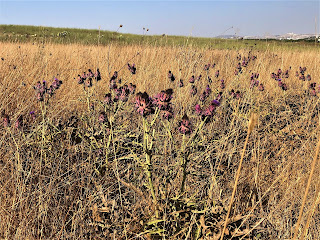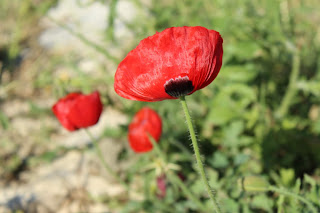,
November 2020 כסלו תשפ"א
I first met the carob tree nearly 20 years ago when I had just arrived in Modiin, long before I ‘discovered’ nature. I had joined a tour of the hills around Modiin to learn a bit of its history with one of those ‘salt of the earth’, ‘craggy’ Israeli guides. My only memory of this tour 20 years later is sitting under a carob tree eating carob syrup. Subconsciously this led me to where I am today – teaching people about nature through its tastes and smells.
When guiding I’m often asked which is my favourite tree. Very simply in a country that is so hot, it is definitely the carob tree as it gives the most shade. Also it has a very thick, reddish trunk which reminds me of tree trunks in England. Its leaves are dense and evergreen and come in the form of leaves and leaflets – a botanical phenomenon where one leaf is made up of lots of little leaves. When the Torah describes the 4 species used on Succot it mentions “……branch of the leafy tree.....” Leviticus 23:40. It was up to our sages to decide which tree this was referring to. The carob was considered as it was so leafy but then dismissed as its fruit was too ugly and the myrtle won the “leafy tree competition”.
The carob tree grows as either a male or a female tree and they need to be near one another so that a bee can take the pollen from a male carob tree in order to fertilize the female one. It is hard to spot the difference as the flowers are quite similar but one very strong characteristic defines the male carob flower – its smell. WARNING SEXUAL CONTENT: The smell is very similar to male semen and once you know that you will always recognize it when passing a carob tree. There is an urban myth that Bedouin men would take their fiancé to a male carob tree and if she recognized the smell then it was a sign that she had sexual experience and she would be executed!
Tree planting is one of the main activities we do at Neot Kedumim Biblical Nature Reserve and I will always tell the story of Honi HaMaagel during a tree planting ceremony:
One day Honi was journeying on the road and he saw an old man planting a carob tree. He said to the man “Why are you planting a tree that you won’t live to eat its fruit?” The man replied: "I ate carob from the trees that my forefathers planted for me, I now plant these for my children."
Honi sat down to have a meal and felt sleepy, he slept for seventy years. When he awoke he saw a man gathering the fruit of the carob tree and Honi asked him, "Are you the man who planted the tree?" The man replied: "I am his grandson."
Shimon Bar Yochai sustained himself and his son for 13 years while living off the fruit of the carob tree. The fruit contains protein, fiber and sugar and therefore makes the perfect natural energy bar – Nature Valley’s competition. It is very sweet but can only be eaten once it has turned fully brown on the tree then you eat the whole pod and just leave the seeds which are very hard so careful not to break your teeth.
The seeds of all carob fruit are all almost identical in size and in weight, each weighing about one fifth of a gram. They also don’t dehydrate so their weight stays consistent. Because of this they were used in ancient times to weigh gold and precious stones and in Greek the carob is called Karat!! Yes that diamond on your finger is hopefully the equivalent in weight to a carob seed!
 |
| Not sure that diamond quite makes it! |
The carob tree in Hebrew is Charuv. One reason is that it grows in very dry conditions, which is known as ‘Charav’ in Hebrew. The fruit also looks like a sword, which in Hebrew is a ‘cherev’. In English however the tree is called the locust tree or St John’s Bread! Both are in relation to the Christian prophet, John the Baptist, who lived in the wilderness and ate carobs (his bread). However due to a confusion with the Greek translation many believe that he actually ate locusts!
Carobs can be used to make a substitute for chocolate although I just don’t get why anyone would do that! They also make a wonderful honey by boiling the pods for about 5 hours until thick syrup is formed. It tastes a little bit like burnt silan (date honey) and is wonderful on yoghurt!
 |
| Picture: Ilana Cohen |









































